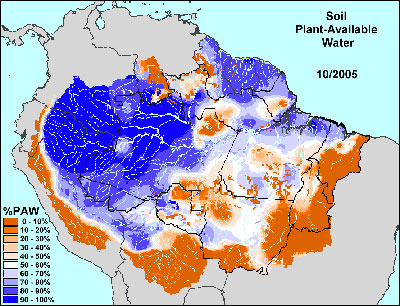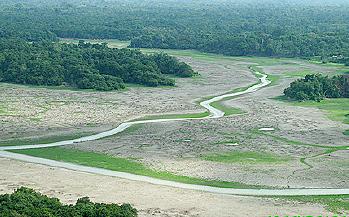One of the worst droughts on record in the Amazon was caused by high temperatures in the Atlantic rather than el Niño, according to analyses of climatic and hydrological records. The research, published in Philosophical Transactions of the Royal Society B, suggests that human-driven warming is already affecting the climate of Earth’s largest rainforest.
In 2005 the Amazon experienced the worst in memory. As rivers dried up, remote communities were isolated while commerce slowed to a standstill. Thousands of square kilometers of land burned for months on end, releasing more than 100 million metric tons of carbon into the atmosphere.
At the time of the drought scientists observed an apparent correlation between sea surface temperatures in the Atlantic Ocean and precipitation in the Amazon. Now research by Dr. Jose Marengo and colleagues from Brazil’s Instituto Nacional de Pesquisas Espaciais (INPE) and the Instituto de Aeronáutica e Espaço (IEA), confirms that “the 2005 drought was linked not to El Niño as with most previous droughts in the Amazon, but to warming sea surface temperatures in the tropical North Atlantic Ocean.”
 According to the WHRC, the above map is “a product of our ongoing drought monitoring effort from Oct. 2005, the worst month we have in our record going back to 1995. It shows moisture stored in the soil which is available for use by plants, what we call ‘Plant-Available Water’ or ‘PAW’, expressed as a percentage of the total water-holding capacity of the top 10m of soil at any given point; %PAW is one of the strongest indicators we have of severity of drought and of forest susceptibility to fire.. Courtesy of WHRC. |
“Very simply, during 2005 there was no El Niño episode occurring in the Tropical Pacific Ocean,” INPE’s Dr. Carlos Nobre told mongabay.com. “Secondly, when El Niños occur, they rarely affect the southwestern Amazon, where the drought hit more intensely.”
“The Tropical North Atlantic Ocean was much warmer during all of 2005 and the meteorological analysis described in the paper showed that anomalous warm sea surface temperature over the Tropical North Atlantic created a relatively low pressure system over that oceanic region. That low pressure changed the wind system over the Tropics. The overall result was descending motion over SW Amazonia, which reduced cloudiness and rainfall.”
Lead author Marengo told mongabay.com that while previous droughts have been linked to El Niño events, 2005 was an anomaly.

Scene from the 2005 drought in the Amazon. Picture courtesy of Greenpeace. |
“The idea of drought episodes during El Niño years is not always correct,” he explained. “During El Niño the drought is more on the central and eastern side of Amazonia (between 5N-10S). That was the case of the droughts of 1926, 1983, 1998 while the drought of 2005 was not during El Niño, and was on the SW side of the basin, similar to another
non El Niño-related drought in 1964.”
“The warming in the tropical North Atlantic was responsible for this drought, since the tropical Pacific was almost neutral (absence of El Niño).”
The conclusion is significant as climate models forecast continue warming in the North Atlantic Ocean due to rising emissions of greenhouse gases. Warm conditions in the North Atlantic Ocean have also been correlated with the formation of hurricanes in the Gulf of Mexico and along the Eastern seaboard of the United States. Hurricane Katrina struck New Orleans in August 2005 [note].
Several climate models for the Amazon project significant warming and drying by 2100 due to rising concentrations of carbon dioxide in the atmosphere. These changes, combined with forecast deforestation and continuing use of fire, could result in the conversion of much of the Amazon rainforest to savanna and scrub.
Marengo, J.A. et al (2008). Hydro-climatic and ecological behaviour of the drought of Amazonia in 2005 [FREE OPEN ACCESS]. Phil. Trans. R. Soc. B, DOI: 10.1098/rstb.2007.0026
- The drought of Amazonia was more intense in austral summer of 2005, and
then the Katrina and very intense hurricane season was in boreal summer
of 2005. Even though those two events were linked to a very warm Tropical
North Atlantic Ocean in 2005, is to hard to say that the drought of Amazonia
and the intense hurricane season in 2005 were associated one to the other.